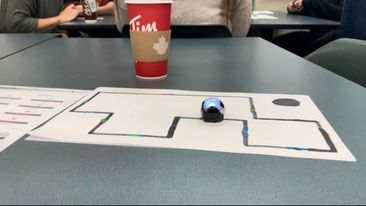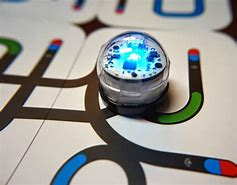Robots and colours and Ozobots, oh my…
These little friends were not only fun to play with but they were also a perfect learning tool to help us understand the 7 Principles of Learning and how they are incorporated into any lesson that goes on in the classroom. This coding experience was very new to me. Working in classrooms as an Educational Assistant, introduced me to the world of coding but I have never done it myself or really understood how it works. Spending a couple of classes playing with these adorable little robots and being introduced to coding did me a world of good. I feel that although I am not an expert on coding by any means, I can begin to introduce it into my classroom and lesson plans.
Having two lectures that incorporated coding helped me as a learner and as a teacher understand the basics and the importance of knowing how to code. It helps students begin to understand how technology works as well as me as a future educator understand the importance of incorporating it into the classroom. Anywho, enough about me…

Here’s how the 7 Principles of Learning are incorporated into the coding of Ozobots…
- Learners at the Centre — one of the most important principles (which probably explains why it’s first) is understanding that each lesson should focus around the students. How it will benefit them? What will they learn? Etc… Using the Ozobots, it was very clear that we (as the learners) were the centre of the lesson. We were encouraged to explore and try different things to learn how the Ozobots work. There were basic codes that we were given that we could alter and merge together with others to make the Ozobot do whatever we wanted.
- The Social Nature of Learning — learning requires many social interactions because we as people learn from others. In accordance with the Ozobots, this principle was incorporated because we were encouraged to work together, in partners, to associate ourselves with these little robots. Although we were working in pairs, everyone ended up working together to get a rounded understanding.
- Emotions are Integral to Learning — Through learning, we feel many emotions. No matter what age we are, learning causes us to become happy, frustrated, etc. Man did we get emotional using these Ozobots. Personally, I felt an abundance of emotions through the process of coding for the Ozobot. I felt happy when it would complete the action I wanted it to do. I felt frustrated when it would only spin in circles.
- Recognizing Individual Differences — Each learner has a different way of learning and being in their daily lives. We got to explore our individuality with the Ozobots because we got to learn in our own way and the way we felt comfortable learning. Some of us worked using trial and error, and others mapped out our plan before even turning the robots on. Each person in the class approached the idea in a completely different way.
- Stretching all students — In the learning environment, each student is encouraged to stretch their learning and expand their thoughts when approaching a new subject. The Ozobots allowed us to put our expanding hats on and expand the basics we were given to get them to do the tricks we wanted.
- Assessment for Learning — With every lesson taught, there is always an assessment that follows. It’s the why to the what. Why did we learn this? Why is it important? etc. Although we weren’t giving a summative form of assessment when working with the Ozobots, we were assessing ourselves on what we learned. We thought about two words we felt associated with our feelings toward Ozobots. We assessed our own learning and came to our own personal conclusion on how we thought that lesson went for us.
- Building Horizontal Connections — Being introduced to the Ozobots and coding as a whole acted as a shadow for the wider world of technology that will be used in the classroom and what we will be encouraged to teach our students. Coding opens such a wide introduction to other things that our students can study.
References
Dumont, Hanna, et al. How Can the Learning Sciences Inform the Design of 21 St Century Learning Environments? The Nature of Learning Using Research to Inspire Practice Edited by Practitioner Guide from The. 2012.
https://www.bing.com/images/search?view=detailV2&ccid=aZ2GlN6I&id=89C26209F78D7357DBB7A296F1EFDCA889F13431&thid=OIP.aZ2GlN6Iiw0_vhiIX74pfAAAAA&mediaurl=https%3a%2f%2fwww.robotshop.com%2fmedia%2fcatalog%2fproduct%2fcache%2fimage%2f400x400%2f9df78eab33525d08d6e5fb8d27136e95%2fo%2fz%2fozobot-bit-diy-skins-pack.jpg&cdnurl=https%3a%2f%2fth.bing.com%2fth%2fid%2fR.699d8694de888b0d3fbe18885fbe297c%3frik%3dMTTxiajc7%252fGWog%26pid%3dImgRaw%26r%3d0&exph=400&expw=400&q=Ozobot+Costumes&simid=607988552959083319&FORM=IRPRST&ck=E225281FA4A8078E412B9E307E7C1CC7&selectedIndex=3&ajaxhist=0&ajaxserp=0

Leave a Reply